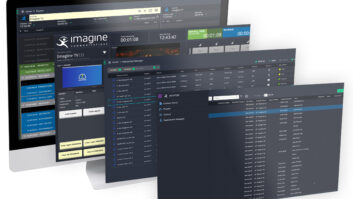
Charlie Vogt sits on the FCC Advisory Council, and is an important member of both the IABM and TIA on the supplier side. He has been the CEO of Imagine Communications for a year, and recently won Finance Monthly’s annual CEO award for his transitional achievements at the company. He talked to George Jarrett.
During the great rush of consolidations around NAB, Harris affected a cute identity switch at the same time as completing the cultural re-direction that so many other corporations are pursuing in the service of TV Everywhere. The acquisitions of Digital Rapids and Imagine happened under the beady eye of Imagine Communications’ CEO Charlie Vogt, who spent much of his career helping Telcos and MSO companies build out their subscriber base access networks. What did he learn back then?
“That there was a huge convergence coming, and you could see it from just spending quality time with the likes of AT&T and Verizon,” he said. “Over the next three to five years we are going to see a pretty significant landscape shift. There were some big moves that go back to 2012 when Disney bought Lucasfilm and CBS bought TV Guide. There has been a lot of activity that has driven new shapes within our space.
“An AT&T or BT has focused for decades on the access plant and being able to provide that last mile of connectivity, whether it is fixed or wireless. The move that you saw AT&T make recently was really a dual one because it quietly acquired two companies – DirecTV ($48.5 billion) and Leap Wireless ($1.2 billion). Leap gives AT&T spectrum it desperately needs, and DirecTV gives it a bigger fixed wire footprint in the home, and it gives it access to subscribers that it does not have today,” he added.
Vogt’s wider market knowledge tells him that the content distributors are trying to control a bigger footprint of the subscriber base. “Eventually, they are going to go upstream and will either create their own content or acquire it. Ultimately, they want to own everything from the lens to the consumer. First and foremost, you have to have the fixed wireless access to be able to do that, and certainly what broadband and the Internet have done is to create a huge opportunity for both entrepreneurs and the really large giants,” he said. “Suppliers like us tend to follow our customers.”
Over 15 to 20 years we saw massive consolidation shifts in the Telco world, followed by a lot of consolidation amongst the supplier community because it was selling into fewer and fewer companies. Taking this as a foreboding, Vogt said, “We went from hundreds of high quality telecom companies that were spending lots of money to 25 or 30, and if you were not selling into these it put pressure on your business. That kind of convergence is going to occur in the media and entertainment space over the next five years,” he added. “We know what Ericsson is doing with its acquisitions from Tandberg to Red Bee, and Cisco has started dabbling in this space with its acquisitions (Collaborate, Assemblage, Threat GRID). There is certainly going to be supplier consolidation as the broadcast and multi-channel video programme distributor market continues to consolidate.”
Some really smart people
So, Imagine had to be savvy in the way it aligned its strategies. How did Vogt apply what he knew from building IP networks to pushing Imagine in a new direction?
“Harris spent close to a billion dollars in the last ten to 15 years on acquiring technology, although there wasn’t a very clear technology vision or strategy that aligned with all the great acquisitions,” he said. “What we have successfully done is to dissect everything we had in the portfolio and do a good job of aligning it with where we know the industry is going.
“If you are convinced it is going to move into a software-defined, IP oriented, cloud-based, TV Everywhere landscape, then you have to start playing the technology innovation and M&A microscoping game in that direction,” he added.
Vogt and his senior staff changed Harris into Imagine by dumping what felt like more of a catalogue of products and switching to a solution-oriented business represented by the three fundamental pillars (portfolios): applications, playout and networking.
“The only reason why you carry out M&A is if the market makes a left or right turn and you are going straight, or if you took-in some technology companies that have found their way two to three years ahead of your roadmap,” he said. “Everybody is on different timelines, and often it is the time-to-market that drives the behaviour within companies to acquire today.
“You do this assessment of ‘make versus buy’, and how long it will take you to get to the trial phase, the adoption phase, and to market. You look at technology, customers and people. That’s why you buy companies,” he added. “We’ve got a very robust R&D roadmap, and will spend $90 million to $100 million, but in the case of Digital Rapids it was doing very different things in software-based/file-based transcoding and encoding, and it had a very unique workflow management platform that we felt was really going to change the landscape.”
For Imagine to develop its own equivalent, assuming it had the intellectual property from a people standpoint, would have taken several years. “Digital Rapids was an easy decision because we are big believers in multi-screen TV Everywhere. Content is going to be distributed to thousands of different devices and the way content is going to be packaged, formatted and delivered is going to be very unique. Digital Rapids brought us some key technology,” said Vogt. “Regarding ‘Little Imagine’ (an in-company name): while it was developing specific encoders and transcoders, it actually had a next generation ABR technology that really hadn’t hit the market.
“We found it to be a huge advantage for us, and both transactions line up in the category of ‘we can get to market a couple of years faster’,” he added. “And we get some really smart people that have been working on this technology for years.”
Going to hit a wall
Vogt believes that companies are still lining up on two sides of a pendulum.
“On one side, people are beginning to recognise that technology needs to be software oriented, and then you have a set of companies that are still in the age of proprietary technology. At some point, they are going to hit a wall,” he said.
Aligning with big customer roadmaps means taking a view on many areas. For example, looking at the Channel-in-a-Box (CiaB) market, Vogt expounds a clear ambition. “We have a strategy to leapfrog the CiaB market. Playout from the cloud and automation from the cloud is really the future of how content is going to be played out and moved throughout the consumer marketplace,” he said.
Imagine has got a second-generation CiaB platform and there certainly will be a market for this for a few years, surely. “Yes. But I believe the future of playout and automation is going to be done in a new way – that is taking advantage of the virtualised network data centre world that we are moving into, and leveraging the cloud,” said Vogt. “I am convinced that’s the future for playout, and I think we are in a unique place because we have really shifted our roadmap to be one that is software focused versus one that is hardware dependent. It gives our customers a lot more flexibility: think how many people would love to turn up certain channels across many different languages for 30 days and then tear it back down and do something else.”
Vogt warms to any mention of the internet or broadband, and the fact that 70 per cent of internet bandwidth is consumed by video is one of his key reference stats.
“Video is going to dominate our market, and because so much time and energy is being spent on ‘how do I move this content more efficiently and more cost effectively’ you are seeing the scarcity around spectrum,” he said. “There is a correlation between the TIA (Telecommunications Industry Association) and the IABM. Those two organisations need to be collaborating because they are supplier organisations.”
Spectrum has been a prickly subject for many years, so what is Vogt’s take on the American situation? “The FCC is struggling a bit with how it balances what seems to be obvious needs versus an even playing field. This is why there have been no decisions made for such a long time,” he said. “Even if the spectrum re-pack happens, it remains a super-heated topic and there are so many lobbyists promoting their own agenda. If it happens it will be great for the wireless players, and it could be very good for many of the broadcasters because most of that spectrum that broadcasters own today is not used in the same way that an AT&T, Verizon or Sprint might use it, especially in the major metropolitan areas. If you just did the forecast – video consumption tapping into the wireless world is massive. It is a real problem.”
More pressure on bandwidth
Vogt acknowledges that 4K for the movies is successful, and he fingers the electronics industry for creating a consumer drive for 4K sets. What people do not see is what’s happening in the middle of the market, he says. “A lot of the large broadcasters and networks have only just got through a major phase from SD to HD, which was expensive and it really didn’t net them a whole lot of incremental revenue,” he said. “They are still struggling with how they make money with 4K, and anything more than HD over the mobile network is going to put more pressure on bandwidth.”
Imagine is not back at base one, wondering if 4K is going to happen or not. It is looking at technology requirements, the technology capability gap with the consumption on the consumer side, and the desire to build the network amongst TV networks and broadcasters. “4K to a mobile device means you are going to need some pretty sophisticated encoding and transcoding technology, which is why we continue to invest in that part of the market,” said Vogt. “We think that is a key area that companies like us are going to be big winners in, as the industry moves more and more of the high quality video content to end devices over the mobile network.”
If traditional content providers can build a strong subscriber base and develop a stronger relationship with the mobile operators, this allows them to create their own destiny to a certain degree. “They are not just dependent on their own broadcasting capabilities in their own traditional manner, and I certainly believe that this is spurring on a whole new thinking about how you monetise content,” he added. “With the subscriber-based model, everybody understands how they get compensated, but in a true advertising supported business model as you shift from the linear model to online, one that is OTT, it creates a highly entrepreneurial opportunity. You have to figure out how to better monetise advertising content away from the traditional linear model.”
Imagine is not the only company spending a lot of development time in the various areas of content exploitation, and Vogt has no illusions when it comes to the challenges. “If we can continue to stay in that food chain, to where we are providing the management tools and the campaign tools that allow users to better manage and monetise content, we are going to be in a pretty good place regardless of how the bits and streams get divided for the various delivery mechanisms,” he said.
With Netflix and Amazon creating their own high quality dramatic content, does it mean the entry level for new players is becoming too costly in terms of content production?
“You are going to see very expensive content used to get into the market, but you can create TV series and movies much more cost effectively. And they can certainly be distributed much more cost effectively than we ever did before,” said Vogt. “There are lots of different business models by which you can monetise content. The ‘re-trans’ opportunity in this new world is huge. It is what created Netflix and HULU up until House of Cards and some of the other new content they are developing themselves. Google is creating its own content, and so is Yahoo. Broadband internet has created an opportunity, and anybody that can leverage this means to a consumer end anywhere in the world, just has limitless opportunity. This is what gets us excited.”
Vogt is talking about managing the whole advertising sales model and incremental monetisation, sophisticated CRM tools, playout and the way playlists are automated, and the archiving and storage of content. He concludes, “It is going to become a bigger part of the overall workflow, and we are going to revolutionise how that whole element gets managed in the future by leveraging virtualisation in the cloud, and IP, in a software-oriented workflow.”






